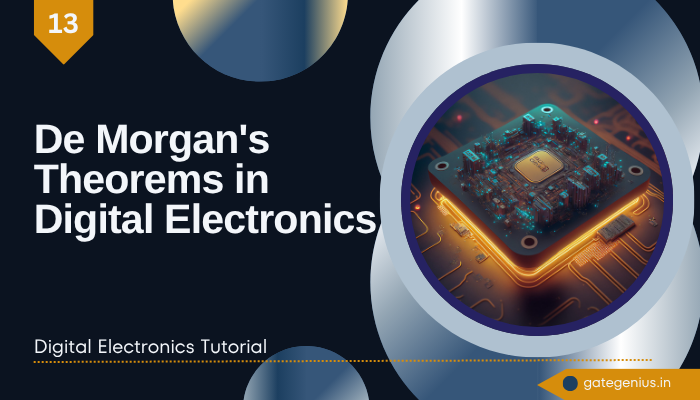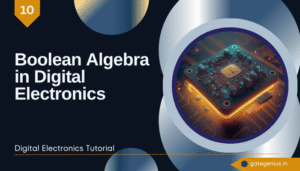When studying Boolean algebra, De Morgan’s Theorems in Digital Electronics serve as a fundamental tool for simplifying logic expressions and optimizing circuit designs. These theorems enable the conversion of AND operations into equivalent OR operations and vice versa, with the inclusion of NOT operations. This transformation is highly valuable in both the theoretical understanding of logic systems and the practical implementation of digital circuits.
In real-world digital system design, there are scenarios where specific gates like AND or OR may be limited due to design constraints or cost factors. In such cases, De Morgan’s Theorems allow designers to convert expressions into forms that utilize only NAND or NOR gates—both of which are universal gates. This capability ensures greater flexibility and efficiency in creating cost-effective and reliable digital circuits.
Let’s dive deep into what these theorems are, how they work, and how they can help us in logic simplification.
What are De Morgan’s Theorems?
De Morgan’s Theorems are two fundamental rules in Boolean algebra named after the British mathematician Augustus De Morgan. These rules are used to transform expressions involving NOT, AND, and OR gates.
There are two De Morgan’s Theorems:
Theorem 1
¬(A · B) = ¬A + ¬B
This means that the complement of an AND operation is equal to the OR of the complements.
In words:
“NOT of A AND B is equal to NOT A OR NOT B”
Theorem 2
¬(A + B) = ¬A · ¬B
This means that the complement of an OR operation is equal to the AND of the complements.
In words:
“NOT of A OR B is equal to NOT A AND NOT B”
Truth Tables of De Morgan’s Theorems in Digital Electronics
Let’s verify these theorems using truth tables.
For Theorem 1: ¬(A · B) = ¬A + ¬B
| A | B | A·B | ¬(A·B) | ¬A | ¬B | ¬A + ¬B |
| 0 | 0 | 0 | 1 | 1 | 1 | 1 |
| 0 | 1 | 0 | 1 | 1 | 0 | 1 |
| 1 | 0 | 0 | 1 | 0 | 1 | 1 |
| 1 | 1 | 1 | 0 | 0 | 0 | 0 |
Result: The values in ¬(A·B) and ¬A + ¬B columns are identical.
For Theorem 2: ¬(A + B) = ¬A · ¬B
| A | B | A+B | ¬(A+B) | ¬A | ¬B | ¬A · ¬B |
| 0 | 0 | 0 | 1 | 1 | 1 | 1 |
| 0 | 1 | 1 | 0 | 1 | 0 | 0 |
| 1 | 0 | 1 | 0 | 0 | 1 | 0 |
| 1 | 1 | 1 | 0 | 0 | 0 | 0 |
Result: The values in ¬(A + B) and ¬A · ¬B columns are identical.
Example Problem
Simplify: ¬(A + B·C)
Solution using De Morgan’s Theorem:
Step 1: Apply Theorem 2:
¬(A + B·C) = ¬A · ¬(B·C)
Step 2: Apply Theorem 1 to second part:
¬(B·C) = ¬B + ¬C
Final Expression:
¬A · (¬B + ¬C)
Why Are De Morgan’s Theorems Important?
De Morgan’s Theorems in Digital Electronics play a significant role in designing efficient and optimised logic circuits. These theorems help simplify complex Boolean expressions and enable the use of alternative gate combinations, making them essential in both theoretical and practical applications of digital logic.
1. Simplification of Boolean Expressions
One of the main uses of these theorems is simplifying logic expressions. By converting AND-OR combinations with NOTs into simpler forms, it becomes easier to reduce the overall complexity of logical operations. This simplification is valuable in both manual design and during logic reduction in automated tools.
2. Gate Replacement for Practical Implementation
In real-world circuits, NAND and NOR gates are often preferred because they are cheaper and easier to implement. With these theorems, logic expressions involving AND and OR gates can be rewritten using only NAND or NOR gates, allowing the same logic to be implemented using fewer types of gates.
3. Circuit Optimization
Simplifying logic not only reduces complexity but also helps minimize the number of gates used in a circuit. Fewer gates mean lower power consumption, faster response time, and reduced space—key factors in compact and efficient digital device design.
4. Design Flexibility with Universal Gates
Since NAND and NOR gates are universal, being able to design entire circuits using just one type of gate offers great flexibility. This is especially useful in hardware implementations where reducing component variety leads to cost savings and streamlined manufacturing.
5. Debugging and Logical Analysis
When analyzing or troubleshooting digital circuits, transforming logic using these theorems can provide new insights. It helps break down complex expressions into simpler equivalents, making it easier to identify logical errors or inefficiencies.
6. Basis for Logic Simplification Tools
Many digital logic design and simulation tools automatically apply these theorems when optimizing circuits. Understanding how and why these transformations happen can help designers make better use of these tools and trust the output they generate.
Frequently asked questions?
Q1. Who gave De Morgan’s Theorems in digital electronics?
A: They were given by Augustus De Morgan, a British mathematician.
Q2. What is the use of De Morgan’s Theorem in logic circuits?
A: It helps convert expressions and logic circuits into simpler or alternate forms using available gates.
Q3. What is the difference between NAND and NOR in De Morgan’s?
A: NAND is based on Theorem 1 (AND form), and NOR is based on Theorem 2 (OR form).
Q4. Are De Morgan’s Theorems reversible?
A: Yes, you can apply them in either direction depending on the requirement.
Q5. Can we use De Morgan’s Theorems for more than 2 variables?
A: Yes, the theorems can be extended to multiple variables.
Conclusion
De Morgan’s Theorems are a powerful tool in digital electronics and Boolean algebra. They simplify complex expressions and help us implement logic circuits more efficiently. These theorems are especially important when designing systems using universal gates like NAND and NOR, making them indispensable for practical circuit optimization. Whether you’re analyzing logic functions or building hardware, mastering De Morgan’s Theorems in Digital Electronics equips you with a solid foundation to approach problems with flexibility and confidence. Understanding and applying these theorems is essential for anyone working in electronics or computer engineering.
I hope you understand De Morgan’s Theorems in Digital Electronics. So don’t forget to share this post with friends and anyone preparing for the GATE, UGC NET exams, or studying at the university.



